Rob Wolf's Blog, page 18
October 6, 2015
Jane Lindskold Creates a Mind with a 'Planet-Sized Body' in her Artemis series
At a time when science fiction is more likely to portray ecosystems collapsing rather than flourishing, Jane Lindskold's Artemis series is an anomaly. Its eponymous planet is not an ecological disaster but rather full of so many wonders that it was once a vacation paradise for a now vanished society.
Of course, like any good science fiction (or fiction, in general, for that matter) Lindskold's Artemis is full of surprises. But Lindskold, who I interviewed on New Books in Science Fiction and Fantasy, takes care not to bludgeon readers with messages about the dangers of science run amok or human interference in nature.
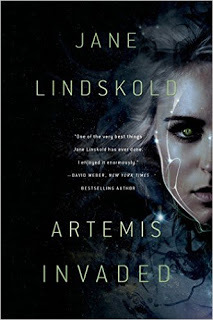
"I thought it was completely possible to tell a story without lecturing people," she says in her New Books interview. "I wanted to put together an exotic and interesting world and let people go adventuring on it with me and if along the way they figured out that ecosystems don't work if they're exploited, great but I'm not going to write lectures."
Artemis is a genuine character in the story, one with an evolving consciousness that communicates regularly with one of the main characters. Lindskold has been frustrated that some reviewers have mistaken Artemis for an artificial intelligence when, in fact, she's a highly complex network made out of various forms of fungi. As Lindskold puts it, "Artemis is a living organism that happens to have a planet-sized body."
Artemis Invaded , published in June, is the second book set on Artemis. The first, Artemis Awakening , came out in 2014. Whether there will be a third remains to be seen, but Lindskold is full of ideas if she gets a green light from the publisher.
"I think a lot about the people on Artemis and what they are doing and would be doing, and I would find it very easy to pick up again. And one thing I've promised myself I would do is if there was a delay between the publication of Book Two and Book Three is that I would write some short stories so that the readership would have something in between."
Follow host Rob Wolf on his blog or on Twitter @RobWolfBooks
Of course, like any good science fiction (or fiction, in general, for that matter) Lindskold's Artemis is full of surprises. But Lindskold, who I interviewed on New Books in Science Fiction and Fantasy, takes care not to bludgeon readers with messages about the dangers of science run amok or human interference in nature.

"I thought it was completely possible to tell a story without lecturing people," she says in her New Books interview. "I wanted to put together an exotic and interesting world and let people go adventuring on it with me and if along the way they figured out that ecosystems don't work if they're exploited, great but I'm not going to write lectures."
Artemis is a genuine character in the story, one with an evolving consciousness that communicates regularly with one of the main characters. Lindskold has been frustrated that some reviewers have mistaken Artemis for an artificial intelligence when, in fact, she's a highly complex network made out of various forms of fungi. As Lindskold puts it, "Artemis is a living organism that happens to have a planet-sized body."
Artemis Invaded , published in June, is the second book set on Artemis. The first, Artemis Awakening , came out in 2014. Whether there will be a third remains to be seen, but Lindskold is full of ideas if she gets a green light from the publisher.
"I think a lot about the people on Artemis and what they are doing and would be doing, and I would find it very easy to pick up again. And one thing I've promised myself I would do is if there was a delay between the publication of Book Two and Book Three is that I would write some short stories so that the readership would have something in between."
Follow host Rob Wolf on his blog or on Twitter @RobWolfBooks
Published on October 06, 2015 21:00
September 3, 2015
Melinda Snodgrass Pits Science Against Religion in Edge of Dawn
What do the jobs of opera singer, lawyer and science fiction writer have in common?
Answer: Melinda Snodgrass.
The author of the just published Edge of Dawn 's first ambition was to sing opera. But after studying opera in Vienna, she came to the conclusion that "I had a nice voice, [but] I didn't have a world-class voice."
She then went to law school and worked for several years as a lawyer. Unfortunately, "I loved the law but I didn't love lawyers," she explains in my interview with her on New Books in Science Fiction and Fantasy.
Her first published books were romance novels, which taught her the "extremely valuable lesson of how to finish what you start. Because that actually is a real problem for people. They'll have brilliant ideas and write the first three chapters and they'll never finish."
Her first science fiction novels, the Circuit Trilogy, drew on her knowledge of the law as she chronicled the adventures of a federal court judge riding circuit in the solar system. She also collaborated with George R.R. Martin to create the shared world series Wild Cards.
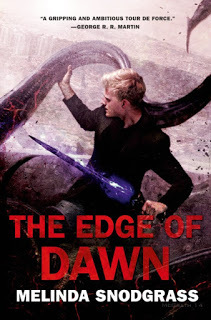 It was Martin who encouraged her to write a spec script for Star Trek: The Next Generation. That spec script, inspired by the Dred Scott decision, turned into the episode
The Measure of a Man
, and a job as story editor for the series.
It was Martin who encouraged her to write a spec script for Star Trek: The Next Generation. That spec script, inspired by the Dred Scott decision, turned into the episode
The Measure of a Man
, and a job as story editor for the series.
Her newest contribution to science fiction is Edge of Dawn, the third book in the saga of Richard Oort, who leads a team seeking to destroy beings from an alternate dimension that use religion to create strife on earth.
The trilogy is in large part a battle between science and religion.
"Science is all about doubt. It's about saying, 'is this real and how can I test it?' ... Religion is about the opposite thing entirely. It's about faith and acceptance of it without questioning, and I think that that can lead to very dangerous results and outcomes," Snodgrass says.
The idea for the series came to her New Year's Eve in 1999. "I thought to myself, why on the dawn of the 21st century are people putting more faith in guardian angels and crystal healing power and tarot card readings than they are in medicine and chemistry and science? ... Why are we seemingly going backwards and becoming more superstitious?" she says. "I cooked up this idea about these creatures encouraging us to believe in fairytales and to fear each other and hate each other on the basis of externalities like the color of our skin, or gender, religion all these different things."
Answer: Melinda Snodgrass.
The author of the just published Edge of Dawn 's first ambition was to sing opera. But after studying opera in Vienna, she came to the conclusion that "I had a nice voice, [but] I didn't have a world-class voice."
She then went to law school and worked for several years as a lawyer. Unfortunately, "I loved the law but I didn't love lawyers," she explains in my interview with her on New Books in Science Fiction and Fantasy.
Her first published books were romance novels, which taught her the "extremely valuable lesson of how to finish what you start. Because that actually is a real problem for people. They'll have brilliant ideas and write the first three chapters and they'll never finish."
Her first science fiction novels, the Circuit Trilogy, drew on her knowledge of the law as she chronicled the adventures of a federal court judge riding circuit in the solar system. She also collaborated with George R.R. Martin to create the shared world series Wild Cards.
 It was Martin who encouraged her to write a spec script for Star Trek: The Next Generation. That spec script, inspired by the Dred Scott decision, turned into the episode
The Measure of a Man
, and a job as story editor for the series.
It was Martin who encouraged her to write a spec script for Star Trek: The Next Generation. That spec script, inspired by the Dred Scott decision, turned into the episode
The Measure of a Man
, and a job as story editor for the series.Her newest contribution to science fiction is Edge of Dawn, the third book in the saga of Richard Oort, who leads a team seeking to destroy beings from an alternate dimension that use religion to create strife on earth.
The trilogy is in large part a battle between science and religion.
"Science is all about doubt. It's about saying, 'is this real and how can I test it?' ... Religion is about the opposite thing entirely. It's about faith and acceptance of it without questioning, and I think that that can lead to very dangerous results and outcomes," Snodgrass says.
The idea for the series came to her New Year's Eve in 1999. "I thought to myself, why on the dawn of the 21st century are people putting more faith in guardian angels and crystal healing power and tarot card readings than they are in medicine and chemistry and science? ... Why are we seemingly going backwards and becoming more superstitious?" she says. "I cooked up this idea about these creatures encouraging us to believe in fairytales and to fear each other and hate each other on the basis of externalities like the color of our skin, or gender, religion all these different things."
Published on September 03, 2015 21:00
August 16, 2015
James L. Cambias Embraces Near Future in Corsair
 For his second novel, James L. Cambias chose one of the most challenging settings for a science fiction writer: the near future.
For his second novel, James L. Cambias chose one of the most challenging settings for a science fiction writer: the near future.Unlike speculative fiction that leaps centuries or millennia ahead or takes place on other planets, a book about the near future presents a world that varies only incrementally from the present. The risk, of course, is that the author's vision will all-too-quickly be proven wrong.
In my conversation with him on New Books in Science Fiction and Fantasy, Cambias explains why he was drawn to the near future and how he navigated those tricky shoals in the writing of Corsair , which follows space pirates as they hunt and plunder treasure (hydrogen mined on the moon) using remote-controlled spacecraft.
Cambias is certain that space piracy will come to pass. "I absolutely expect that some point that space piracy or space hacking... will become a criminal enterprise. Space hardware is just too valuable," he says.
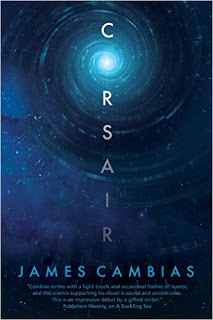 Cambias also discusses the Hieroglyph Project, which is trying to get science fiction authors to write the kind of visionary fiction that has the capacity to spark brick-and-mortar innovation. Cambias contributed to the project's collection of short stories but also penned a series of blog posts in which he declares the project a "failure."
Cambias also discusses the Hieroglyph Project, which is trying to get science fiction authors to write the kind of visionary fiction that has the capacity to spark brick-and-mortar innovation. Cambias contributed to the project's collection of short stories but also penned a series of blog posts in which he declares the project a "failure."Related links:
This is Cambias' second appearance on New Books in Science Fiction and Fantasy. His first interview, about his book A Darkling Sea, is available here.
An episode of New Books was also devoted to the Hieroglyph Project.
Follow host Rob Wolf on his blog or on Twitter @RobWolfBooks
Published on August 16, 2015 21:00
July 31, 2015
New Collection Offers Scandinavian Twist to Speculative Fiction

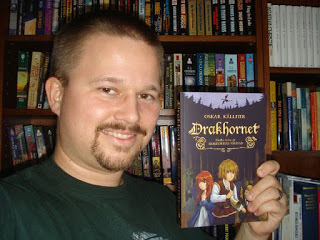 There's far more to Swedish literature than Pippi Longstocking and The Girl with the Dragon Tattoo. That's the message my guests on the latest episode of New Books in Science Fiction and Fantasy, Anna Jakobsson Lund and Oskar K�llner, are trying to send the English-speaking world through their contributions to Waiting for the Machines to Fall Asleep (Affront Publishing, 2015), a collection of short stories by Swedish authors.
There's far more to Swedish literature than Pippi Longstocking and The Girl with the Dragon Tattoo. That's the message my guests on the latest episode of New Books in Science Fiction and Fantasy, Anna Jakobsson Lund and Oskar K�llner, are trying to send the English-speaking world through their contributions to Waiting for the Machines to Fall Asleep (Affront Publishing, 2015), a collection of short stories by Swedish authors.Until recently, the world of science fiction in Sweden was so small that it was possible to keep up with everything that was published. But no more. The genre, thanks in part to self-publishing, is "blooming," Lund says.
The few big Swedish publishers are starting to catch up. "The big publishing houses think [science fiction and fantasy] is something that stops with young adults... and there's not any status for a writer to be writing science fiction or fantasy," Lund says.
But K�llner says, "Game of Thrones is beginning to change that."
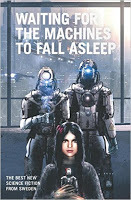 Lund says writing a story in English provided a chance to use more ornate language. "As a Swedish writer ... you do things a bit minimalistic." But English allowed her a fresh take. "I [could] use a bit more adjectives than I usually allow myself."
Lund says writing a story in English provided a chance to use more ornate language. "As a Swedish writer ... you do things a bit minimalistic." But English allowed her a fresh take. "I [could] use a bit more adjectives than I usually allow myself."In one sign of the difference between the United States and Sweden, K�llner says he has had some of his most successful book signings in grocery stores. "I usually stand somewhere between the bananas and loaves of bread and smile," he says.
Published on July 31, 2015 21:00
July 14, 2015
Porochista Khakpour's The Last Illusion blends 9/11 with magic

My newest podcast is about a book that takes a fabulist twist on a story about the months leading up to 9/11. As interesting at the book itself is its author, Porochista Khakpour, who has written candidly not only about her experience being a Middle Eastern immigrant to the U.S. in a post-9/11 world but also about her struggle with both physical illness and depression. Below is my write up about the podcast for the New Books in Science Fiction and Fantasy web site:
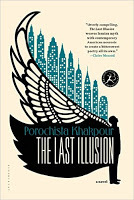 Porochista Khakpour moved to an apartment with large picture windows in downtown Manhattan shortly before September 11, 2001, giving her a painfully perfect view of the terrorist attacks.
Porochista Khakpour moved to an apartment with large picture windows in downtown Manhattan shortly before September 11, 2001, giving her a painfully perfect view of the terrorist attacks."The big event of my life was of course 9/11," Khakpour says. "I experienced a lot of post traumatic stress from it and think about it constantly."
It's no surprise that the assault on the Twin Towers features prominently in her writing. Through non-fiction essays and two novels, the Iranian-born writer has tried to understand the tragedy's impact on her, the nation, and the world.
But while her essays are rooted in facts, her fiction takes flight. In The Last Illusion there are, in fact, multiple references to flight. The main character, an albino man named Zal, is raised by his abusive mother in a cage among a balcony full of birds. Although he cannot fly, he yearns to. Rescued by an American and brought to New York in the years before 9/11, he tries to unlearn his feral ways and finds himself drawn to visionaries--an artist who claims to see the future and a famous magician who aspires, in a feat of illusionist virtuosity, to make the then still-standing World Trade Center disappear.
The character of Zal is based on a Persian myth and Khakpour infuses the story with fabulous twists and turns.
"My biggest challenge was doing a mythic retelling of a summer before 9/11 and not just any summer but Y2K to the summer before 9/11... Luckily, what was great about the realism was that the realism was quite surreal. If you look at the Y2K narrative, not to mention the 9/11 narrative, it's full of the magical, full of the fabulist, full of the kind of impossible."
In her New Books interview, Khakpour discusses the impact of 9/11 on "everyone":
"I'm kind of amazed when I meet people who think it didn't really affect them or the event wasn't that big a deal in their life. Maybe the actual day wasn't but their lives have completely been altered, even just economically. Anyone who has a job today has been affected by it."
She speculates about the trepidation publishers might have had about a book that uses myth and fantasy modes to tell a story about 9/11:
"It took over two and half years to sell this book whereas my first book only took a few months.... If I'd done a purely realistic take from say a Middle Eastern woman's perspective, my guess is it would have sold faster but this idea that I was using a fabulous mode, a sort of speculative mode, and addressing this sensitive world event and then add to the fact that here I am, you know, a brown person addressing this--that caused I think some complications.
About her connection to her protagonist Zal, who, like her is an Iranian-born immigrant:
"I don't think I've ever written a character that I've identified with more."
Related links:
Khakpour's magician in The Last Illusion was inspired by the real life example of David Copperfield, who made the Statue of Liberty "disappear" in a television special in the 1970s. Here's a clip on YouTube.
Follow Porochista Khakpour on Twitter.
Follow host Rob Wolf on his blog or on Twitter @RobWolfBooks.
Published on July 14, 2015 21:00
June 23, 2015
An Author Who Blogs about Real Sex, Writes Novels about Fictional Magic, and is Named after a Rodent

One of the most surprising things I learned during my interview with Ferrett Steinmetz is that the blogger who writes candidly about his most intimate experiences--including his polyamory and struggles with depression--is also socially anxious. He predicted that after our conversation, he'd need a few hours of Clone Wars and solitude to recover.
Of course, I shouldn't be surprised that a writer is quirky. After all, I'm a writer and I'm kinda quirky. And I can be socially anxious too. But enough about me. Here's my summary of our conversation that I posted on New Books in Science Fiction and Fantasy:
Ferrett Steinmetz first built an audience as a blogger, penning provocative essays about "puns, politics and polyamory" (among other things) with titles like "Dear Daughter: I Hope You Have Awesome Sex" and "How Kids React To My Pretty Princess Nails."
In recent years, he has drawn accolades as an author of speculative fiction, writing short stories and earning a Nebula nomination in 2011 for his novelette Sauerkraut Station .
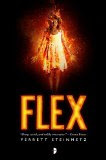 And now he is exploring new waters with the publication of his first novel,
Flex
(Angry Robot, 2015), which tells the story of a father desperate enough to use illegal magic to heal his badly burned daughter.
And now he is exploring new waters with the publication of his first novel,
Flex
(Angry Robot, 2015), which tells the story of a father desperate enough to use illegal magic to heal his badly burned daughter.The title refers to crystalized magic that, when snorted, gives the user the power to manipulate objects for which he or she has a particular affinity. Cat ladies become felinemancers. Weightlifters become musclemancers. Graphic artists become illustromancers. And the protagonist, a paper-pushing bureaucrat by the name of Paul Tsabo, becomes a bureaucromancer, able to turn paperwork (with the help of flex) into a magical beast.
The only problem is that with flex comes flux--a pushback from the universe that re-balances any magic act with disaster.
Below are highlights from Steinmetz's New Books interview.
On what he learned at Clarion Writers' Workshop:
"Bit by bit they kind of stripped away my illusions and showed me how lazy I'd been and how much more effort I had to put to make my stories top notch. ... I thought I was a one and a half draft person, but realistically I have to put in 5 drafts before the story starts to get good."
On how paperwork can become magical in Paul Tsabo's hands:
"He's basically useless in a firefight but can send a SWAT team through your door by dropping a magically completed warrant for your arrest on a cop's desk."
On why he why a world with flex also needs flux:
"Flux evens out the odds of magic.... I really hate novels where magic is this thing you can do ... without any kind of cost.... Frequently what I see is, 'Oh, I'm a magician. I'll raise an army of the dead and make my castle out of magic,' and where is any challenge in that for your characters? Where do they have any stopping points to what they can do?... A big tension in the book as to whether the mancers should even use their magic."
On his approach to writing:
"I'm what's called a gardener writer in the business. There are plotters who basically sit down and plot out all their books beat by beat and know their ending the minute they start their first sentence. And Flex, like every story I've ever written-- basically I wrote an interesting first paragraph and followed it randomly until the end of the book."
On 9/11 as an inspiration for Flex:
"To a large extent the magic system in Flex is driven by a reaction to 9/11, where something really bad happened--and yes it really was bad... but we really overreacted that wasn't helpful at all and in fact may have made it entirely worse for us."
Related links:
Follow Ferrett Steinmetz on his blog or on Twitter.
Follow host Rob Wolf on his blog or on Twitter @RobWolfBooks.
Published on June 23, 2015 21:00
June 6, 2015
Meg Elison Knocks it Out of the Park with her First Novel
I spoke with this year's winner of the Philip K. Dick Award, Meg Elison, for my 18th podcast on New Books in Science Fiction and Fantasy. She was easy breezy to talk to, with smart quick answers that, in my humble opinion, made for a great interview. Of course, it helps that her book tackles all kinds of rich subjects: gender inequality (exacerbated by an epidemic that kills far more women than men), reproductive rights, and a need for meaningful emotional and intellectual stimulation in a world sorely lacking both. Below is what I wrote to introduce the podcast.
Despite the odds, Meg Elison did it.
First, she finished the book she wanted to write. Second, she found a publisher--without an agent. Third, she won the Philip K. Dick Award for Distinguished Science Fiction, a stunning achievement for a first-time author with a small, independent press.
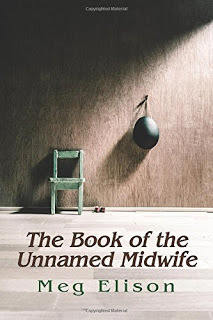 The Book of the Unnamed Midwife
is set in the American West after an epidemic has killed all but a fraction of humanity. Among the survivors, men vastly outnumber women, setting in motion a desperate journey of survival for the eponymous midwife. To avoid the serial rape and enslavement that threatens all females in this male-dominated landscape, the midwife sheds her name and even her sexuality, presenting herself as a man and continuously changing her moniker to suit the circumstance.
The Book of the Unnamed Midwife
is set in the American West after an epidemic has killed all but a fraction of humanity. Among the survivors, men vastly outnumber women, setting in motion a desperate journey of survival for the eponymous midwife. To avoid the serial rape and enslavement that threatens all females in this male-dominated landscape, the midwife sheds her name and even her sexuality, presenting herself as a man and continuously changing her moniker to suit the circumstance.
Communication falls apart too quickly for anyone to even know the name or nature of the illness that's destroyed civilization and made childbirth a fatal event for female survivors. The midwife's focus is on giving the few women she meets the hard-won power to prevent pregnancy. "I think the thing I wanted to come across most strongly was to explode notions of gender... And to really think about what your options would be like if you, like your grandmother, had no control over when you had children or how or by whom," Elison says in her New Books interview.
Elison was raised on stories about the apocalypse--the fire and brimstone kind. "I grew up in some pretty crazy evangelical churches, and they hammered on us about the end of days and the Book of Revelation, and it gave me nightmares, and it made always think about the fact that the end was nigh and that it was going to be bad, and I think that stuck with me my whole life even though I shed the ideological parts of it."
For the midwife, the apocalypse poses threats both dramatic and mundane. When not searching for food and a safe place to spend the night, she must negotiate the frustrating reality of spending time with people she doesn't like. "I started thinking about what it would be like if the only people you could find were people you couldn't stand, if they just irritated in you every way," Elison says. "There's nothing wrong with them and they're not unsafe, you just don't like being there. So I wanted to make a character who had to make choices between feeling safe in a group of people and feeling pissed off all the time."
Elison is grateful for the editors at Sybaritic Press, who published her unagented manuscript. "They're very good editors and publishers," she says. But inevitably, she's had to do a lot of marketing herself. "It's good because I've learned a lot about the business doing that and it's not good because no one listens to a writer on her own."
Fortunately, the Philip K. Dick Award has made finding readers a whole lot easier. The award "has opened a lot of doors," she says.
Related links:
An article in the Los Angeles Review of Books explores the book's treatment of "Gender and the Apocalypse." [Note: the article has spoilers].
Meg Elison shares her thoughts on her blog.
You can follow New Books in Science Fiction and Fantasy on Twitter and Facebook and host Rob Wolf on Twitter.
Despite the odds, Meg Elison did it.
First, she finished the book she wanted to write. Second, she found a publisher--without an agent. Third, she won the Philip K. Dick Award for Distinguished Science Fiction, a stunning achievement for a first-time author with a small, independent press.
 The Book of the Unnamed Midwife
is set in the American West after an epidemic has killed all but a fraction of humanity. Among the survivors, men vastly outnumber women, setting in motion a desperate journey of survival for the eponymous midwife. To avoid the serial rape and enslavement that threatens all females in this male-dominated landscape, the midwife sheds her name and even her sexuality, presenting herself as a man and continuously changing her moniker to suit the circumstance.
The Book of the Unnamed Midwife
is set in the American West after an epidemic has killed all but a fraction of humanity. Among the survivors, men vastly outnumber women, setting in motion a desperate journey of survival for the eponymous midwife. To avoid the serial rape and enslavement that threatens all females in this male-dominated landscape, the midwife sheds her name and even her sexuality, presenting herself as a man and continuously changing her moniker to suit the circumstance.Communication falls apart too quickly for anyone to even know the name or nature of the illness that's destroyed civilization and made childbirth a fatal event for female survivors. The midwife's focus is on giving the few women she meets the hard-won power to prevent pregnancy. "I think the thing I wanted to come across most strongly was to explode notions of gender... And to really think about what your options would be like if you, like your grandmother, had no control over when you had children or how or by whom," Elison says in her New Books interview.
Elison was raised on stories about the apocalypse--the fire and brimstone kind. "I grew up in some pretty crazy evangelical churches, and they hammered on us about the end of days and the Book of Revelation, and it gave me nightmares, and it made always think about the fact that the end was nigh and that it was going to be bad, and I think that stuck with me my whole life even though I shed the ideological parts of it."
For the midwife, the apocalypse poses threats both dramatic and mundane. When not searching for food and a safe place to spend the night, she must negotiate the frustrating reality of spending time with people she doesn't like. "I started thinking about what it would be like if the only people you could find were people you couldn't stand, if they just irritated in you every way," Elison says. "There's nothing wrong with them and they're not unsafe, you just don't like being there. So I wanted to make a character who had to make choices between feeling safe in a group of people and feeling pissed off all the time."
Elison is grateful for the editors at Sybaritic Press, who published her unagented manuscript. "They're very good editors and publishers," she says. But inevitably, she's had to do a lot of marketing herself. "It's good because I've learned a lot about the business doing that and it's not good because no one listens to a writer on her own."
Fortunately, the Philip K. Dick Award has made finding readers a whole lot easier. The award "has opened a lot of doors," she says.
Related links:
An article in the Los Angeles Review of Books explores the book's treatment of "Gender and the Apocalypse." [Note: the article has spoilers].
Meg Elison shares her thoughts on her blog.
You can follow New Books in Science Fiction and Fantasy on Twitter and Facebook and host Rob Wolf on Twitter.
Published on June 06, 2015 21:00
June 2, 2015
Multi-tasking is Ken Liu's Middle Name
Published on June 02, 2015 21:00
April 27, 2015
An Imagination Too Big for One Life (or One Name)
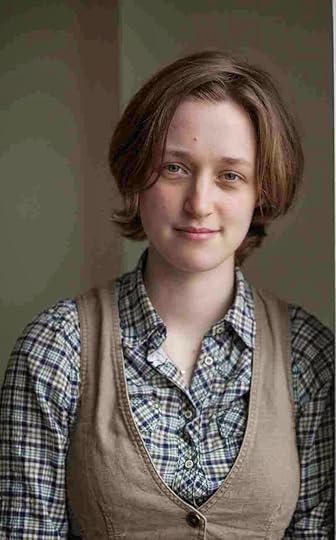 When an author creates a character, she can churn through as many re-writes as she'd like until she gets it right. This, of course, is in stark contrast to reality, where people get only one shot. There's no going back, no do-overs, only an inexorable march to the end.
When an author creates a character, she can churn through as many re-writes as she'd like until she gets it right. This, of course, is in stark contrast to reality, where people get only one shot. There's no going back, no do-overs, only an inexorable march to the end.But what if life were different? Catherine Webb, under the pen name Claire North, offers two worlds where this is possible. In The First Fifteen Lives of Harry August (2014), she introduces the reader to kalachakra, people who are reborn into the lives they've already lived. The eponymous protagonist, for example, is reborn 15 times at midnight on the cusp between 1918 and 1919.
This is both wonderful and challenging, Webb explains in her New Books interview.
"It's both liberating because he can go through his childhood knowing everything that's going to happen in coming events because he's already lived it, but it's also horrendous because he can be 5 years old on his 11th life being treated like a 5-year-old... and being forced to re-live his ABCs even though he's actually hundreds of years old."
Touch (2015) offers a different way to escape the drudgery of a single, linear life. The main character, Kepler (a moniker assigned by those trying to destroy it), can travel from body to body with a touch. This allows it to live hundreds of years, experiencing the world like a tourist on an endless trip.
Inevitably, the life of a kalachakra or a body-hopping consciousness can become tedious. Harry August struggles with apathy, having seen that whatever he achieves in one life is erased with the reset of his birth. Kepler, too, struggles to find meaning beyond its focus on survival. The ingredients which ordinary people use to measure their lives don't matter to Kepler. For one thing, it no longer has a gender because it can occupy men and women with equal ease. Nor does it have to experience even mild discomfort: whenever it encounters anything not to its liking, it can jump to another body. Even a hangnail can be enough to send it packing.
Webb herself is no stranger to multiple identities. A fan of pen names (she switches among Catherine Webb, Kate Griffin and Claire North depending on the genre and audience), she is as dexterous at changing writing styles as she is at inventing engaging characters and plots, although sometimes she's only aware of the shift in style after the fact, almost as if someone else--her own Kepler perhaps?--had done the work.
"I'm not necessarily aware consciously of a decision to write in a different style. ... The story has its own logic. I let that do the work, and then I'm surprised to turn around and discover that Kate Griffin sounds very different from Claire North."
Published on April 27, 2015 21:00
'Podcast No. 16: An Imagination Too Big for One Life (or One Name)
 When an author creates a character, she can churn through as many re-writes as she'd like until she gets it right. This, of course, is in stark contrast to reality, where people get only one shot. There's no going back, no do-overs, only an inexorable march to the end.
When an author creates a character, she can churn through as many re-writes as she'd like until she gets it right. This, of course, is in stark contrast to reality, where people get only one shot. There's no going back, no do-overs, only an inexorable march to the end.But what if life were different? Catherine Webb, under the pen name Claire North, offers two worlds where this is possible. In The First Fifteen Lives of Harry August (2014), she introduces the reader to kalachakra, people who are reborn into the lives they've already lived. The eponymous protagonist, for example, is reborn 15 times at midnight on the cusp between 1918 and 1919.
This is both wonderful and challenging, Webb explains in her New Books interview.
"It's both liberating because he can go through his childhood knowing everything that's going to happen in coming events because he's already lived it, but it's also horrendous because he can be 5 years old on his 11th life being treated like a 5-year-old... and being forced to re-live his ABCs even though he's actually hundreds of years old."
Touch (2015) offers a different way to escape the drudgery of a single, linear life. The main character, Kepler (a moniker assigned by those trying to destroy it), can travel from body to body with a touch. This allows it to live hundreds of years, experiencing the world like a tourist on an endless trip.
Inevitably, the life of a kalachakra or a body-hopping consciousness can become tedious. Harry August struggles with apathy, having seen that whatever he achieves in one life is erased with the reset of his birth. Kepler, too, struggles to find meaning beyond its focus on survival. The ingredients which ordinary people use to measure their lives don't matter to Kepler. For one thing, it no longer has a gender because it can occupy men and women with equal ease. Nor does it have to experience even mild discomfort: whenever it encounters anything not to its liking, it can jump to another body. Even a hangnail can be enough to send it packing.
Webb herself is no stranger to multiple identities. A fan of pen names (she switches among Catherine Webb, Kate Griffin and Claire North depending on the genre and audience), she is as dexterous at changing writing styles as she is at inventing engaging characters and plots, although sometimes she's only aware of the shift in style after the fact, almost as if someone else--her own Kepler perhaps?--had done the work.
"I'm not necessarily aware consciously of a decision to write in a different style. ... The story has its own logic. I let that do the work, and then I'm surprised to turn around and discover that Kate Griffin sounds very different from Claire North."
Published on April 27, 2015 21:00



